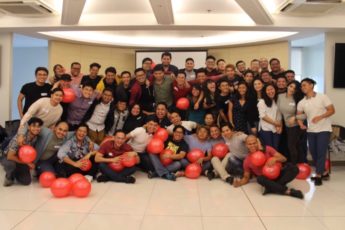The HIV crisis has gone on for four decades, and for four decades the world has struggled against it. Doctors, scientists, educators, policy makers, writers, artists – people of all walks and all colors have, in their own ways, sought to make sense of this crisis and its relationship with society. From citizens to states, from medicine to prayer, from cures to cries for reform, people’s visions of how to respond to the crisis are as diverse as the people who bear its scars. The goal of this series is to give you a glimpse of these visions: the roles people of different passions and disciplines have played in this crisis that, as of March 2016 as recorded by the Department of Health’s Epidemiology Bureau, is infecting 25 Filipinos daily.
In his 1963 book, The Press and Foreign Policy1, American political scientist Bernard C. Cohen likened journalists to cartographers: they influence, with the “maps” they draw, how the public comes to see the world. “The press may not be successful much of the time in telling people what to think,” Cohen writes, “but it is stunningly successful in telling its readers what to think about.”2 Maxwell McCombs and Donald Shaw, in a 1972 issue of Public Opinion Quarterly3, found a real-world example. Studying the 1968 presidential campaign in Chapel Hill, North Carolina, they came to what is now an obvious conclusion: that mass media shapes voter beliefs about what are important issues. They were not the first to say this, of course. The idea surfaced as early as 1922 by newspaper columnist Walter Lippman4 and others.
No debate here: the media can set the agenda5. Frequent reporting of select issues, prominent story placement, additional inches on a newspaper column, extended airtime — the media’s strategies are subtle and many. But as much as this power can direct the public, it can also alienate them.
HIV: An underreported issue
Independent journalist and sexual health advocate Ana P. Santos works with the Pulitzer Center on Crisis Reporting6, an institution that supports journalists working on underreported issues. A two-time grantee, she has reported on migrant mothers as well as HIV (Human Immunodeficiency Virus) in the Philippines. Her stories have been published in various international titles, including The New York Times, The Washington Post, The Los Angeles Times, IRIN News, and The Guardian.
Santos believes interest in HIV has not waned, but she admits there are challenges, even for independent journalists like her, to getting these kinds of stories published. “I’m an independent journalist, so I have to focus on issues that are important to me and balance them out with issues that my editors from overseas want me to focus on,” she explains. “And the editors overseas, they all want a story about the president.” True enough, local newsrooms haven’t had a slow day since the presidential campaigns. Since President Rodrigo Duterte’s election, more and more political stories have been produced, from the president’s war on drugs to his controversial pronouncements, the state visits, Senate hearings, the Marcos burial — the list goes on. “There’s been a lot of unprecedented moments in this new administration,” Santos tells us. “It is a real challenge in terms of getting your stories out there and also getting people to pay attention.” Internationally, it is the same challenge. Other issues, such as the refugee crisis, the rise of violent extremism, and the looming shadow of climate change, simply have more traction than HIV/AIDS.
But Santos has found a way to write about HIV despite these editorial interests. In “Philippines’ war on drugs affecting fight against HIV”7, her September 2016 report for the German publication Deutsche Welle (DW), she angled the story to satisfy both her editors’ requirement to deliver news on the president and her personal advocacy. The result is a riveting investigative piece that delved deep into the rising number of HIV infections among people who inject drugs (PWID) in Cebu, and how the government’s criminal approach8,9,10 to its anti-drug campaign has crippled HIV intervention programs. “First, it was the drug war, and then it has now become a geopolitical issue. These are increasingly important. Yes, they’re important, but so is HIV.” Santos mentioned geopolitics because the president’s often controversial statements concerning international relations11,12 are top news for editors too, and these also tend to overshadow other issues like the HIV epidemic.
Humanizing the epidemic
A published story with all “news values” (such as timeliness, impact, conflict, proximity, and prominence) is good, but it’s the storytelling that makes it great. “Treatment trumps topic,” as the American Press Institute puts it.13 For a reader, storytelling can become more important than the story itself. “The best story is a well-told tale about something the reader feels is relevant or significant.”14

For sensitive topics like HIV, well-written human interest features (or people-focused stories told with an emotional angle) fit the mold of a great story. These great stories can resonate with readers because they showcase real people with real struggles and real victories. But even then, journalists face roadblocks. “There’s less resistance to HIV stories on children15 and mothers16,” Santos explains. “When you talk about HIV in terms of, for example, PWID, sex workers, and people in prison, people think, ‘Who cares about these people?’ So there’s always that challenge.” One solution is, somewhat ironically, to make the subject human: “I think the way that journalism can address that is to frame it around people. This isn’t a prisoner; this is someone like you and me. This isn’t a person who injects drugs; this is a person like you and me.”
But journalists aren’t just journalists either: they’re people like you and me, and like most of us aren’t immune to the emotional toll stories like these have17,18,19. In Santos’ case, it was meeting children living with HIV that weighed heavy on her: “When we were doing the drug den story in Cebu…we found children who are living with HIV. And that bothered me the most. One 9-year-old girl said that she would, at times, be the one to buy the drugs for her mother. She didn’t realize it, and she was sometimes at the shooting galleries.” Santos’ advice is to “detach”, to take a step back and to “detoxify”. This means moving away from the stressful situation and letting the strong emotions pass before continuing the legwork.
There’s a need for journalists reporting on HIV to go beyond the numbers if they want a wider readership. In an article for the Center for Health Journalism20, Jon Cohen writes: “The best HIV/AIDS coverage delves beyond the latest statistics of how many people are infected, the publication of a new national plan, or the results from a study of a promising new treatment or preventive intervention. It tells the stories of the vulnerable people who took part in that study and offers different perspectives about the results. It airs debates that took place behind closed doors while the new policy was being formed. It explains the complex, confusing forces that drive how an epidemic changes shape over time.” In short, quality coverage is comprehensive: it probes for information, provides context, and offers perspective.
In the Philippines, where HIV remains a touchy subject, putting a face on the epidemic can be daunting. People living with HIV (PLHIV) could fear estrangement from their communities because of their condition and refuse to become sources for journalists. And for Santos, the first rule is to do no harm: “the safety and the dignity of PLHIVs should be your paramount concern.” This means protecting sources and reporting their stories with utmost care, getting informed consent, honoring requests for anonymity, getting in touch with the right people (like experts and reputable organizations), disclosing all details about the story (like the angle, and where and when it will be published), and so on. She recalls: “We were in a drug den… My photographer, Veejay [Villafranca], because he had a camera, they [PWID] were asking, ‘What’s that?’ Veejay asked, ‘Sir, could we take some pictures? We won’t show your faces.’ And then he [Veejay] would show them the photos, so they eased up. But no one wanted to talk to me at first, and I was the only woman in the room. Finally, somebody came up to me and asked, ‘Ate, what do you need?’ I said, ‘No one’s talking to me. I just need to get an interview. Is it alright?’ She said, ‘Okay, but let me inject first, okay?’ Will you be able to wait? Are you in a hurry?’ I said, ‘No, no, no. I’ll wait for you. Promise, I’ll talk to you.’”
Learning the science, getting the support
Part of the job is to stay on top of the beat or the subject. For those reporting on HIV, this means being up-to-date on the latest social and medical advancements. In the Philippines, for example, journalists need to learn how to report on Pre-exposure Prophylaxis (PrEP)21, a pill that, with correct and consistent use, was demonstrated by clinical research to lower the risk of HIV transmission by up to 92%22.
According to Santos, a shift from ‘awareness’ to ‘understanding’ is necessary. It’s not enough for readers to know there’s an HIV epidemic in the country23; readers need to know about the epidemic’s beginnings, its present state, and where it’s headed. “There’s a lot of reporting, but let’s move beyond awareness already… You need to go beyond creating awareness to now establishing understanding and then creating positive conversations and dialogues.” Going beyond awareness also means journalists need to go beyond the figures. While solid research is the foundation of any good report, presentation matters. This means translating medical jargon and complicated statistics into clear stories that are readily accessible to readers unfamiliar to the subject24,25,26.
“HIV, when you report on it, you need to be sensitive to the realities of the people that you report on,” Santos says. “You also have to be scientifically accurate. That’s what I rely on the government for, especially with new things like PrEP. It’s technical again. Now, there’s something new again to understand. And I think that’s where the partnership of journalists and the government should come in because we have to be accurate.” One example is the Department of Health (DOH), which releases the HIV/AIDS and ART Registry of the Philippines (HARP)27 every month. Note however that reporters must be extra critical when dealing with technical data: closer inspection could at times reveal gaps in official reports, which should be addressed28.
Aside from community sources and government data, journalists can tap other entities for support. For Santos’ story on PWIDs in Cebu, she enlisted the help of a known non-government HIV testing and support organization in the province. “In Cebu, we had the support of Cebu Plus29. Cebu Plus is one of those organizations that are trusted. We also had the support of the city health department. So we talked to them. We told them what the story’s going to be about. We engaged them. We also got a briefing from them about what to expect. And we were granted access. But you never go in there without someone who’s known in the community.”
LoveYourself30 also works with members of the media to help them get HIV stories out. Volunteers have served as resource persons for news and investigative reports, and the organization has connected journalists with other sources for their stories. LoveYourself also regularly shares content through its website31, the Rappler X page32, and other social media channels33,34,35, which can be sources of reliable information for readers and story ideas for reporters. Santos tells us: “I look to you [LoveYourself] for support groups and guidance. If I were to write a transgender story now, for example, and I have to look for an expert on transgender issues, I would ask somebody from LoveYourself.”
With adequate support, the journalist’s job of producing quality reports on HIV is made easier. And while making HIV the headline story of the day remains a big undertaking, journalists can turn to tested strategies to get their stories the attention they deserve. But once the story is out, its value rests solely in the hands of the readers. Because while journalists might be the cartographers, it’s the readers who do the traveling.
Text by Jean Natividad
Photos Ana Santos & Veejay Villafranca




